Abstract
Giardia lamblia has been grown in vitro only in media containing serum or serum fractions. How this pathogen can grow in the human small intestinal lumen without serum is not known. We found that samples of human hepatic or gall bladder bile maintained G. lamblia survival for 24 to 48 h in medium without serum but did not support growth. By contrast, an artificial biliary lipid dispersion containing six bile salts, phosphatidylcholine (PC), and cholesterol, in the ratios characteristic of human bile, supported parasite growth in medium without serum or serum fractions. To define the requirements, we showed that 1-palmitoyl-2-linoleoyl-PC or 1-palmitoyl-2-oleoyl-PC (which predominate in human bile) satisfied the requirement for PC. Moreover, either glycocholate or glycodeoxycholate could be substituted for the bile salt mixture. The finding that biliary lipids can support serum-free growth of G. lamblia may help explain why this parasite colonizes the upper small intestine.
Full text
PDF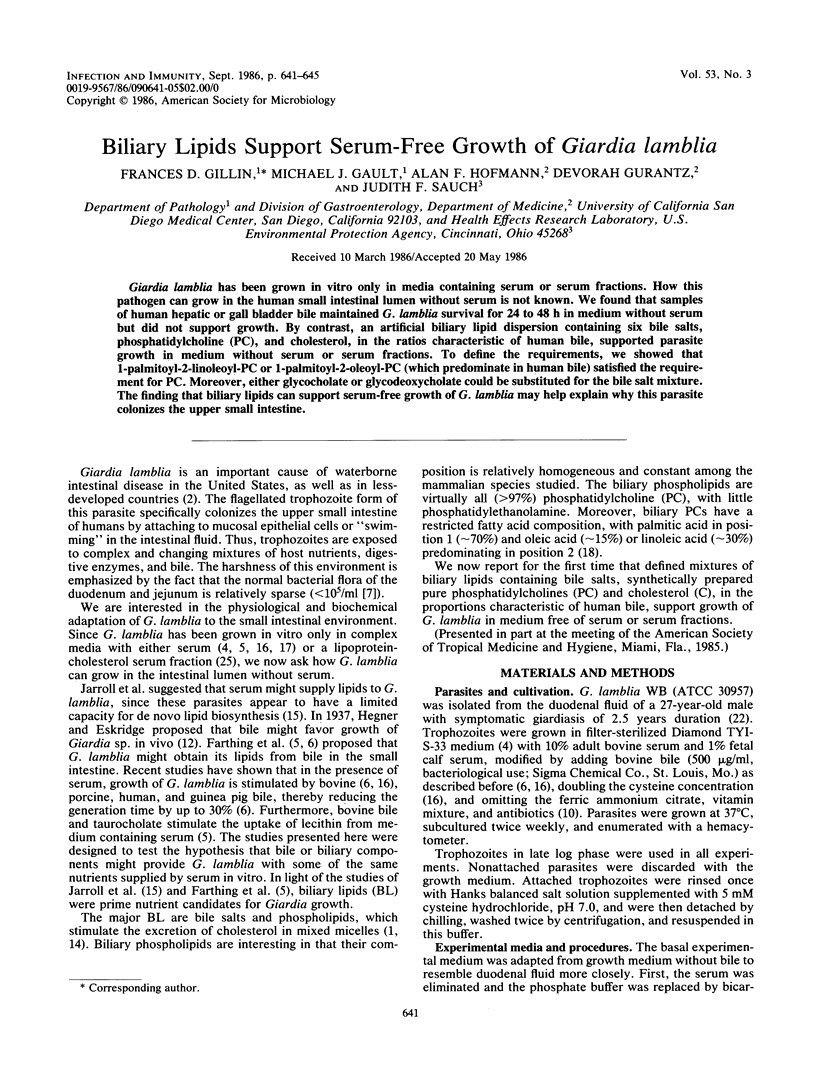
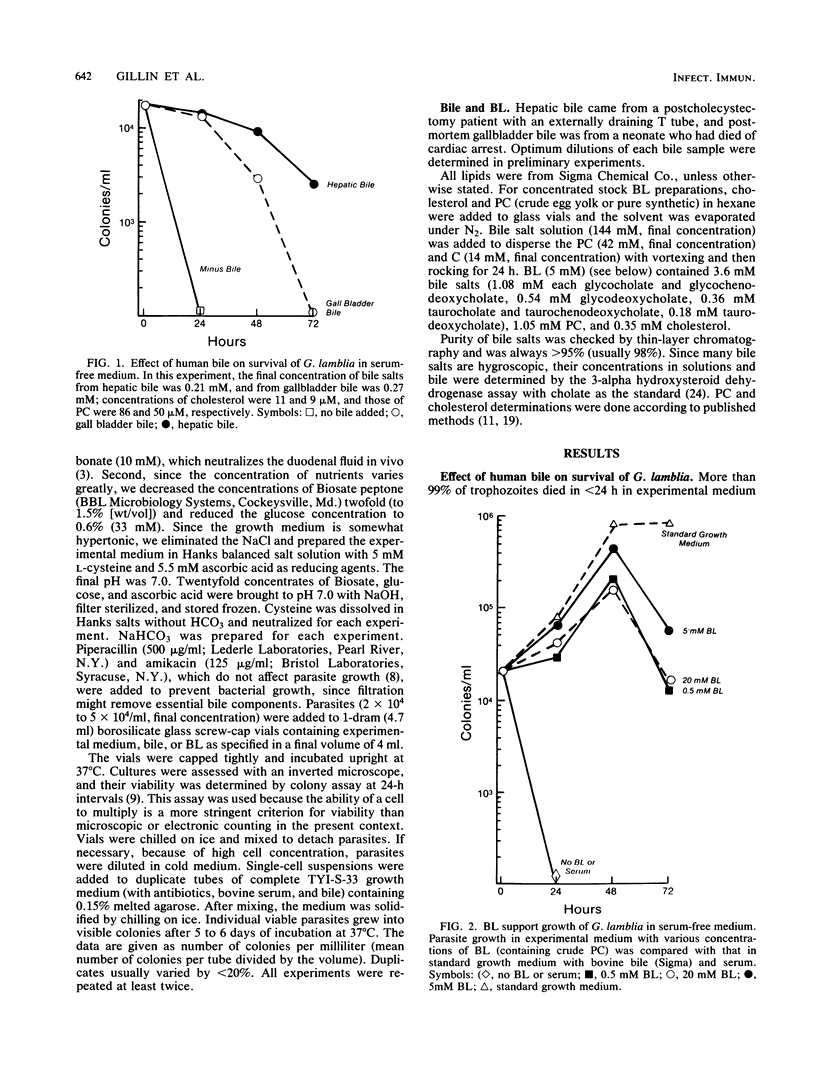
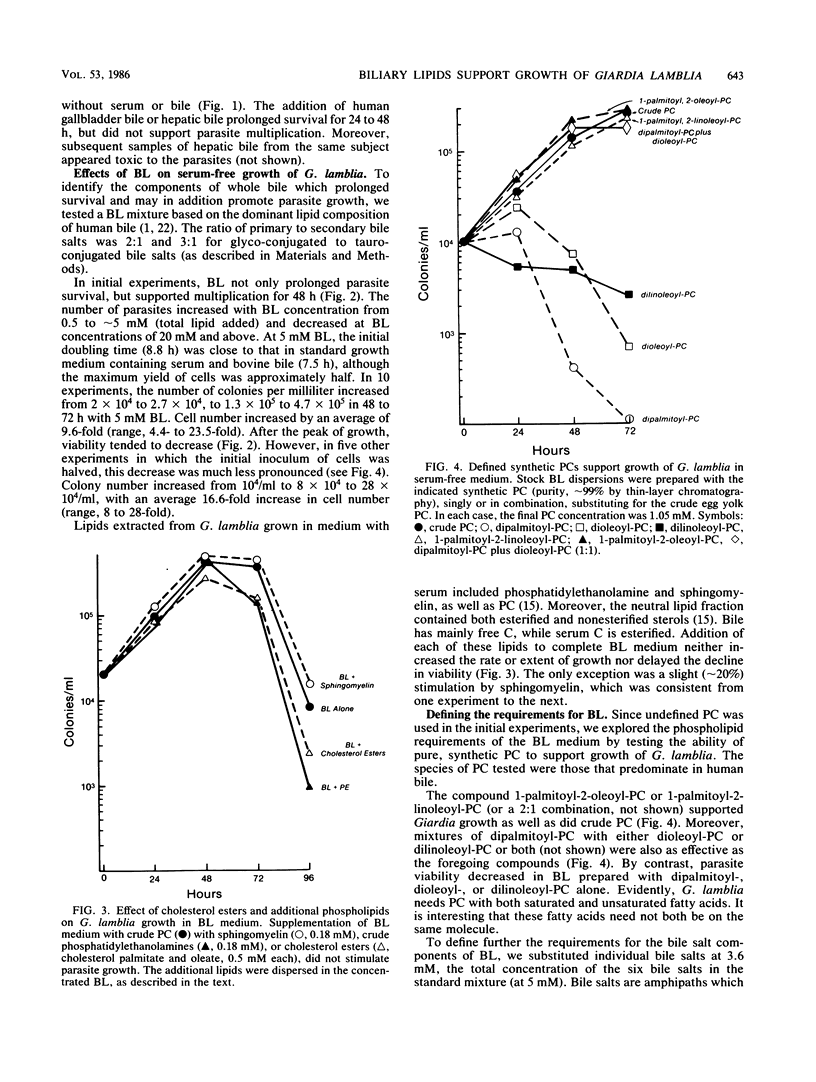
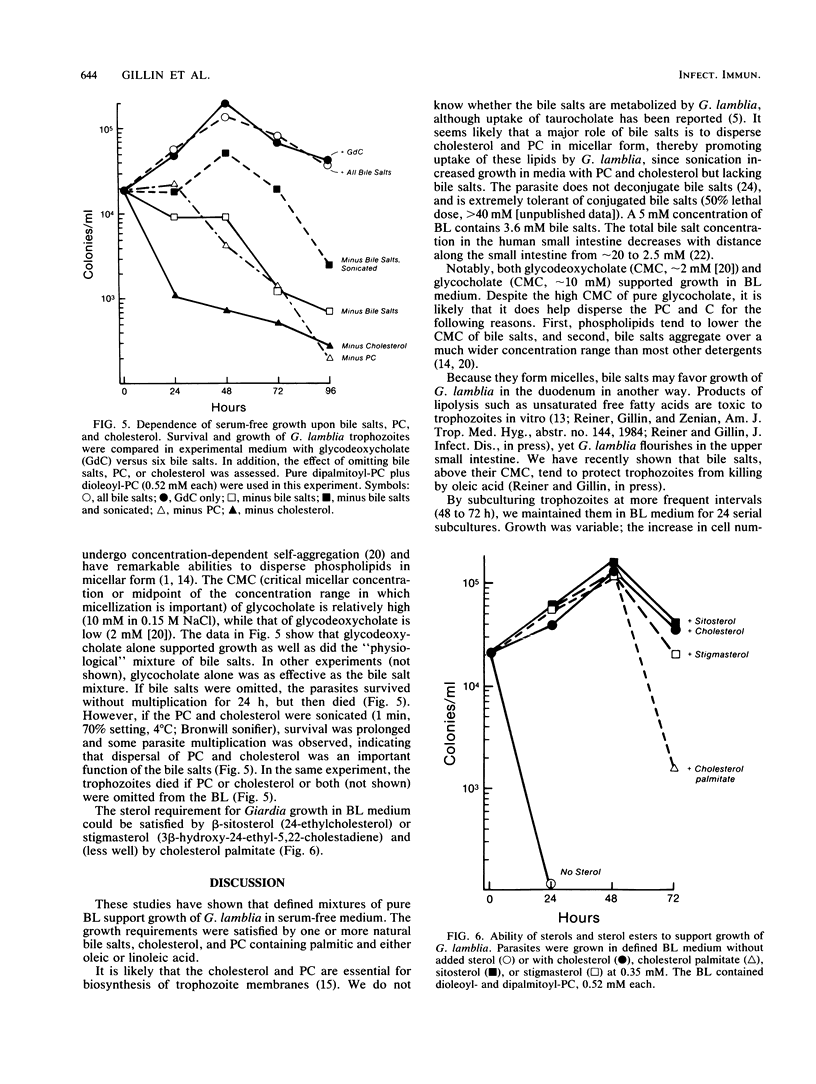
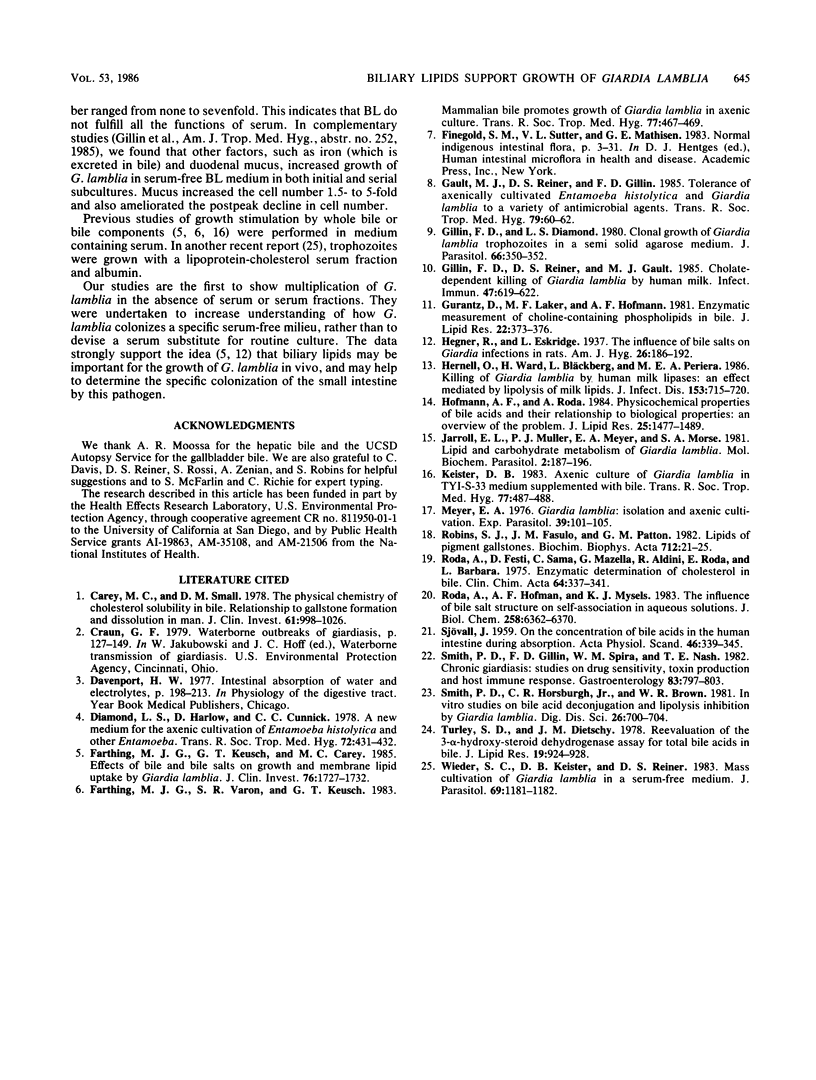
Selected References
These references are in PubMed. This may not be the complete list of references from this article.
- Carey M. C., Small D. M. The physical chemistry of cholesterol solubility in bile. Relationship to gallstone formation and dissolution in man. J Clin Invest. 1978 Apr;61(4):998–1026. doi: 10.1172/JCI109025. [DOI] [PMC free article] [PubMed] [Google Scholar]
- Diamond L. S., Harlow D. R., Cunnick C. C. A new medium for the axenic cultivation of Entamoeba histolytica and other Entamoeba. Trans R Soc Trop Med Hyg. 1978;72(4):431–432. doi: 10.1016/0035-9203(78)90144-x. [DOI] [PubMed] [Google Scholar]
- Farthing M. J., Keusch G. T., Carey M. C. Effects of bile and bile salts on growth and membrane lipid uptake by Giardia lamblia. Possible implications for pathogenesis of intestinal disease. J Clin Invest. 1985 Nov;76(5):1727–1732. doi: 10.1172/JCI112162. [DOI] [PMC free article] [PubMed] [Google Scholar]
- Farthing M. J., Varon S. R., Keusch G. T. Mammalian bile promotes growth of Giardia lamblia in axenic culture. Trans R Soc Trop Med Hyg. 1983;77(4):467–469. doi: 10.1016/0035-9203(83)90115-3. [DOI] [PubMed] [Google Scholar]
- Gault M. J., Reiner D. S., Gillin F. D. Tolerance of axenically cultured Entamoeba histolytica and Giardia lamblia to a variety of antimicrobial agents. Trans R Soc Trop Med Hyg. 1985;79(1):60–62. doi: 10.1016/0035-9203(85)90236-6. [DOI] [PubMed] [Google Scholar]
- Gillin F. D., Diamond L. S. Clonal growth of Giardia lamblia trophozoites in a semisolid agarose medium. J Parasitol. 1980 Apr;66(2):350–352. [PubMed] [Google Scholar]
- Gillin F. D., Reiner D. S., Gault M. J. Cholate-dependent killing of Giardia lamblia by human milk. Infect Immun. 1985 Mar;47(3):619–622. doi: 10.1128/iai.47.3.619-622.1985. [DOI] [PMC free article] [PubMed] [Google Scholar]
- Gurantz D., Laker M. F., Hofmann A. F. Enzymatic measurement of choline-containing phospholipids in bile. J Lipid Res. 1981 Feb;22(2):373–376. [PubMed] [Google Scholar]
- Hernell O., Ward H., Bläckberg L., Pereira M. E. Killing of Giardia lamblia by human milk lipases: an effect mediated by lipolysis of milk lipids. J Infect Dis. 1986 Apr;153(4):715–720. doi: 10.1093/infdis/153.4.715. [DOI] [PubMed] [Google Scholar]
- Hofmann A. F., Roda A. Physicochemical properties of bile acids and their relationship to biological properties: an overview of the problem. J Lipid Res. 1984 Dec 15;25(13):1477–1489. [PubMed] [Google Scholar]
- Jarroll E. L., Muller P. J., Meyer E. A., Morse S. A. Lipid and carbohydrate metabolism of Giardia lamblia. Mol Biochem Parasitol. 1981 Feb;2(3-4):187–196. doi: 10.1016/0166-6851(81)90099-2. [DOI] [PubMed] [Google Scholar]
- Keister D. B. Axenic culture of Giardia lamblia in TYI-S-33 medium supplemented with bile. Trans R Soc Trop Med Hyg. 1983;77(4):487–488. doi: 10.1016/0035-9203(83)90120-7. [DOI] [PubMed] [Google Scholar]
- Meyer E. A. Giardia lamblia: isolation and axenic cultivation. Exp Parasitol. 1976 Feb;39(1):101–105. doi: 10.1016/0014-4894(76)90016-3. [DOI] [PubMed] [Google Scholar]
- Robins S. J., Fasulo J. M., Patton G. M. Lipids of pigment gallstones. Biochim Biophys Acta. 1982 Jul 20;712(1):21–25. doi: 10.1016/0005-2760(82)90079-0. [DOI] [PubMed] [Google Scholar]
- Roda A., Festi D., Sama C., Mazzella G., Alini R., Roda E., Barbara L. Enzymatic determination of cholesterol in bile. Clin Chim Acta. 1975 Nov 3;64(3):337–341. doi: 10.1016/0009-8981(75)90364-2. [DOI] [PubMed] [Google Scholar]
- Roda A., Hofmann A. F., Mysels K. J. The influence of bile salt structure on self-association in aqueous solutions. J Biol Chem. 1983 May 25;258(10):6362–6370. [PubMed] [Google Scholar]
- SJOVALL J. On the concentration of bile acids in the human intestine during absorption. Bile acids and sterioids 74. Acta Physiol Scand. 1959 Aug 31;46:339–345. doi: 10.1111/j.1748-1716.1959.tb01763.x. [DOI] [PubMed] [Google Scholar]
- Smith P. D., Gillin F. D., Spira W. M., Nash T. E. Chronic giardiasis: studies on drug sensitivity, toxin production, and host immune response. Gastroenterology. 1982 Oct;83(4):797–803. [PubMed] [Google Scholar]
- Smith P. D., Horsburgh C. R., Jr, Brown W. R. In vitro studies on bile acid deconjugation and lipolysis inhibition by Giardia lamblia. Dig Dis Sci. 1981 Aug;26(8):700–704. doi: 10.1007/BF01316858. [DOI] [PubMed] [Google Scholar]
- Turley S. D., Dietschy J. M. Re-evaluation of the 3 alpha-hydroxysteroid dehydrogenase assay for total bile acids in bile. J Lipid Res. 1978 Sep;19(7):924–928. [PubMed] [Google Scholar]
- Wieder S. C., Keister D. B., Reiner D. S. Mass cultivation of Giardia lamblia in a serum-free medium. J Parasitol. 1983 Dec;69(6):1181–1182. [PubMed] [Google Scholar]


